
Phase-modulated split-t2 two-pulse program
for 3QMAS of half-integer spin quadrupole nuclei.
Contribution of R. Hajjar

Phase-modulated split-t2 two-pulse program
for 3QMAS of half-integer spin quadrupole nuclei.
Contribution of R. Hajjar
Below NMR pulse program describes the basic two-pulse sequence with split-t2 approach for (1D and 2D) +3Q-MAS experiment applied to quadrupolar nuclei with half-integer spin.

Fig. 1: Phase-modulated split-t2 two-pulse 3QMAS NMR sequence and echo transfer pathway of a spin I = 3/2.
This NMR pulse program is for Bruker Avance spectrometers.
A pure absorption 2D spectrum is obtained without the shearing transformation.
; split-t2_2p3q ; 3Q MAS pulse program for half-integer spin nuclei ; 2 pulse experiment with full echo split-t2 acquisition: ; excitation - t1(3Q) - conversion (-1Q) - ACQ(-1Q) ; Optimise P2 then P1, 2 or more iterations for P1 and P2 ; may be needed. ;parameters ;ns : 24*n ;d1 : recycle delay ;p1 : excitation pulse at pl11 ;p2 : conversion pulse at pl11 ;pl1 : = 120 db (not used) ;pl11 : power level for excitation and conversion pulses ;d6 : to allow full echo to build up when d10 = 0 ;d10 : = 1u ;in10 : 1 rotor period for synchronised experiment ;cnst31 : MAS spin rate ;for 3/2 nuclei set: in11 = in10*7/9 ;for 5/2 nuclei set: in11 = in10*19/12 ;for 7/2 nuclei set: in11 = in10*101/45 ;td1 : number of t1-experiments ;FnMODE : QF ;MC2 : QF "d6=((1s*l1)/cnst31)-(p1/2)-(p2/2)" ze ; clear memory, new data replace old data, ; switch AD converter to replace mode, ; perform DS before next acquisition, 1 d1 ; recycle delay, 10u pl11:f1 ; 10 microsecond delay, ; set high power in f1 channel, (p1 ph1):f1 ; high-power excitation pulse, d6 ; echo delay, d10 ; t1 increment, (p2 ph2):f1 ; high-power conversion pulse, d11 ; acquisition delay go=1 ph31 ; signal acquisition, ; loop to 1, ns times for averaging, d1 mc #0 to 1 F1QF(id10&id11) ; delay for disk I/O, store signal, ; increase FID number, ; delete memory data, ; do not perform dummy scans ; with next acquisition, ; increment time d10 by in10, ; increment time d11 by in11, exit ; end of the pulse program ph1=(12) {0 2 4 6 8 10}^3^6^9 ; excitation pulse phase with CYCLOPS ph2= {0 0 0 0 0 0 }^1^2^3 ; conversion pulse phase with CYCLOPS ph0= 0 ph31= {0 2 0 2 0 2 }^1^2^3 ; receiver phase with CYCLOPS
The phase cycling of ph1, ph2, and ph31 is identical to that of amplitude-modulated two-pulse sequence. As the whole echo is detected, the antiecho becomes undectable. Therefore, no extra phase cycling is necessary to select the echo transfer pathway.